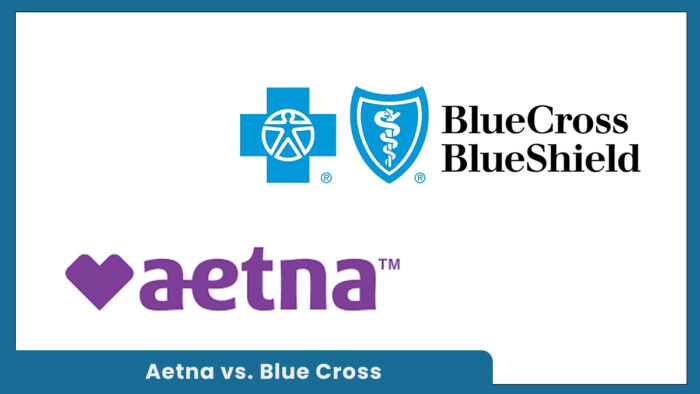Aetna vs. Blue Cross: What You Need to Know – Aetna and Blue Cross Blue Shield are two of the largest health insurance providers in the country. Both offer a wide range of plans, extensive provider networks, and specialized programs to help manage chronic conditions.

This comparison focuses on their Affordable Care Act (ACA) plans and Medicare Advantage options. Key factors such as availability, plan variety, pricing, and customer satisfaction were taken into account. Blue Cross Blue Shield tends to be a stronger choice for ACA marketplace coverage, while Aetna stands out when it comes to Medicare Advantage plans. However, the best option for you will ultimately depend on your specific healthcare needs and personal preferences.
Aetna Health Insurance: What You Need to Know
Aetna is a long-standing health insurance provider that began operations in 1853 as Aetna Life Insurance Company. In 2018, it became part of CVS Health, which helped expand its reach and services. Today, Aetna has a large national network that includes 1.8 million healthcare professionals, over 6,000 hospitals, and close to 10,000 CVS pharmacy locations.
One of the key benefits of choosing Aetna is the access to exclusive discounts and benefits on select CVS products and services. This connection with CVS makes it easier for policyholders to manage routine healthcare needs in one place. In addition, Aetna’s Affordable Care Act (ACA) plans are known for having relatively low copayments for doctor visits and prescriptions, making them more affordable for everyday healthcare expenses.
Pros:
- Aetna policyholders can receive discounts and special allowances for certain CVS products and services: Since Aetna is owned by CVS Health, members often enjoy exclusive savings on health-related items and services at CVS locations. This partnership adds extra value to the coverage, especially for routine care and wellness products.
- Aetna’s ACA plans offer low average copays for doctor visits and prescription medications: For those enrolled in an ACA plan, out-of-pocket costs for primary care and prescriptions tend to be lower compared to many competitors. This makes it easier to access everyday healthcare without financial strain.
Cons:
- Aetna’s Medicare Advantage plans often have high drug deductibles: While Aetna’s Medicare Advantage plans offer strong coverage in many areas, their prescription drug deductibles can be higher than average. This means members may pay more upfront before their drug coverage begins.
- ACA plans are only available in 17 states: Although Aetna offers quality ACA plans, they are not accessible nationwide. If you live outside those 17 states, you will need to consider a different insurer for ACA marketplace coverage.
About Blue Cross Blue Shield
Blue Cross Blue Shield (BCBS) is made up of 33 independent health insurance companies operating under a shared brand. Together, they serve over 115 million members across all 50 states. The organization began in 1929 and became the Blue Cross Blue Shield Association in 1982. These member companies provide a broad range of health coverage, including ACA marketplace insurance, Medicare Supplement plans (Medigap), Medicare Part D for prescription drugs, Medicare Advantage plans, and employer-sponsored health insurance.
Pros:
- Blue Cross Blue Shield offers a wide variety of ACA plan types: Members can choose from an extensive range of Affordable Care Act (ACA) health plans, allowing them to select coverage that fits both their medical needs and budget. This variety ensures flexibility, whether someone wants a lower premium, lower deductible, or broader network.
- ACA plans are widely available across the United States: Blue Cross Blue Shield plans are offered in all 50 states through its network of independent companies. This broad availability makes it one of the most accessible options for individuals and families shopping for ACA coverage.
Cons:
- Medicare Advantage plans from Blue Cross Blue Shield tend to have higher-than-average premiums: Although the company offers comprehensive Medicare Advantage coverage, the cost of these plans can be higher than what some other insurers charge. This might be a concern for retirees on fixed incomes.
- ACA plans from Blue Cross Blue Shield often come with high overall costs: In many cases, monthly premiums and out-of-pocket expenses like deductibles and copays can be higher than average. This may affect affordability, especially for those who do not qualify for government subsidies.
Aetna vs. Blue Cross Blue Shield: Policy Types
When shopping for health insurance through the marketplace, you will notice several plan types that differ based on cost sharing and provider access. These plans are categorized into metal levels and provider network types.
Metal Levels:
Marketplace health plans are divided into four main tiers: bronze, silver, gold, and platinum. There is also a catastrophic tier designed for people under 30 or individuals with low incomes who meet specific criteria. The metal levels reflect how costs are shared between you and the insurance provider. Bronze plans generally offer the lowest monthly premiums but require higher out-of-pocket payments when you receive care. In contrast, platinum plans come with the highest premiums but cover a larger portion of medical expenses. Health plans also differ by the type of provider network they use:
- Health Maintenance Organization (HMO): You must use doctors within the plan’s network and need a referral from your primary care provider to see a specialist. These plans are usually the most cost-effective.
- Exclusive Provider Organization (EPO): Like HMOs, EPOs require you to stay in-network, but referrals to see specialists are typically not needed. They may come at a slightly higher cost than HMOs.
- Preferred Provider Organization (PPO): PPOs allow you to see out-of-network providers, although at a higher cost. These plans offer the most flexibility but also tend to be more expensive.
Plan Offerings:
Both Aetna and Blue Cross Blue Shield offer HMO, EPO, and PPO options on the ACA marketplace. However, Blue Cross Blue Shield provides a broader selection of metal levels, including catastrophic, bronze, expanded bronze, silver, gold, and platinum. Aetna’s marketplace offerings are more limited, focusing on expanded bronze, silver, and gold plans. Both insurers also offer Medicare Supplement (Medigap), Medicare Part D, and Medicare Advantage plans.
Aetna vs. Blue Cross Blue Shield: Price Comparison
In general, Blue Cross Blue Shield offers more affordable ACA plans than Aetna. According to Investopedia’s review, this conclusion is based on a mix of premium costs, deductibles, out-of-pocket limits, and copay amounts. However, your final costs will depend on individual factors such as age, state of residence, and plan selection.
Average ACA Marketplace Costs
| Cost Type | Aetna | Blue Cross Blue Shield |
| Monthly Premium (Individual) | $553 | $561 |
| Monthly Premium (Family) | $1,989 | $2,015 |
| Deductible (Individual) | $5,880 | $3,939 |
| Deductible (Family) | $11,759 | $7,904 |
| Out-of-Pocket Max (Individual) | $7,228 | $7,197 |
| Out-of-Pocket Max (Family) | $14,457 | $14,393 |
Aetna vs. Blue Cross Blue Shield: Availability
In terms of availability, Blue Cross Blue Shield offers ACA health plans in 32 states and Washington, D.C., while Aetna currently offers ACA plans in only 17 states. If you often travel or live in different locations throughout the year, both insurers provide options for out-of-state care.
Aetna members can visit CVS MinuteClinic locations across the country and receive care under their plans. Blue Cross Blue Shield uses the BlueCard program, which allows members to access in-network prices when receiving care in other states that have a BCBS presence.
Aetna vs. Blue Cross Blue Shield: Medicare Advantage
Both companies also participate in the Medicare Advantage program, which is an alternative to Original Medicare. These private plans cover hospital and medical services and often include additional benefits.
Aetna provides Medicare Advantage coverage in nearly all states and has a slightly higher average star rating compared to Blue Cross Blue Shield. Aetna also offers lower average premiums, making it a more cost-effective choice for some. However, Blue Cross Blue Shield stands out with lower average drug deductibles and out-of-pocket costs, which may benefit members with frequent prescription needs.
Aetna vs. Blue Cross Blue Shield: Discounts and Savings
Both Aetna and Blue Cross Blue Shield offer members additional ways to save on health-related products and services through their unique discount programs.
Aetna members benefit from its relationship with CVS Health. This partnership gives members access to $0 visits at CVS MinuteClinics, which can be helpful for minor illnesses or preventive care. In addition, Aetna offers $3 copays for generic prescriptions filled at CVS Pharmacy locations. Members also receive a $25 quarterly credit to spend on CVS-branded wellness items such as over-the-counter cold medicines, allergy relief products, and pain relievers. However, this credit is not available in California, Missouri, or New Jersey.
On the other hand, Blue Cross Blue Shield provides its members access to the Blue365 discount program. Through this platform, members can find savings on a wide range of wellness-related goods and services. These include discounts on fitness gear, gym memberships, vision and hearing care, nutrition programs, and even travel and lifestyle items. By signing into the Blue365 portal, members can browse current offers from participating brands such as LensCrafters and Nutrisystem.
Each company’s discount program enhances the overall value of their health plans by helping members save money on everyday wellness expenses.



